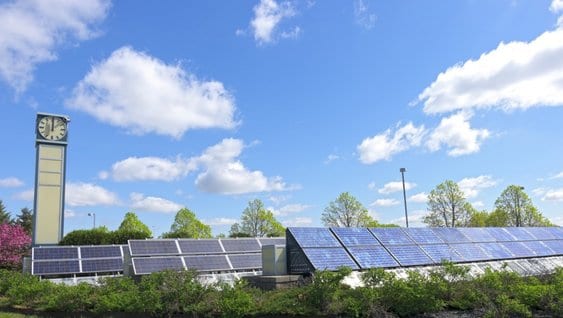For much of the recent rise of solar power, the industry has been divided in two: distributed rooftop solar, and utility-scale solar parks. According to a new report from GTM Research, a third type of solar in which consumers share renewable energy installations is set to take off this year — and to represent a large market share of the industry by 2020.
Known as community solar, solar gardens, or more simply shared solar, GTM researchers found that the U.S. “market is approaching a tipping point.” With a total of 66 megawatts installed cumulatively by the end of 2014, the report predicts that installations will grow five-fold in 2015, with 115 megawatts installed. By 2020, there will be 1.8 gigawatts, nearly equivalent to the total amount of solar power installed in the United States in 2012.
Designed for those without rooftop access, these shared solar projects will open up opportunities for some 50 percent of current U.S. households and businesses that are unable to host a photovoltaic system due to site unsuitability, ownership, or multi-unit status, according to a recent National Renewable Energy Laboratory (NREL) analysis. The analysis found that by bringing shared solar to these households and businesses that are unable to host on-site PV, shared solar could represent 32 to 49 percent of the distributed solar market in 2020, representing $8.2–$16.3 billion of cumulative investment.
“Historically, PV business models and regulatory environments have not been designed to expand access to a significant portion of potential PV system customers,” said David Feldman, NREL energy analyst and lead author on the report. “As a result, the economic, environmental, and social benefits of distributed PV have not been available to all consumers.”
The GTM analysis found that while there are 24 states with at least one community solar project in operation, California, Colorado, Massachusetts, and Minnesota will install the bulk of the community solar projects at least for the next two years.
On Tuesday, the Obama administration added to the momentum by announcing a new Energy Department program to help build community solar systems as part of a larger effort to install 300 megawatts of solar power in subsidized housing by 2020. White House officials including Brian Deese, Obama’s top energy advisor, told reporters that around half of all U.S. households don’t have access to solar because they are renting or don’t have enough usable space.
“We need to expand opportunities for more families to reap the benefits of using cleaner sources of energy that can also help households save money on their utility bills,” said Deese.
In most instances of community solar, third-party solar developers will contract with utilities to sell them electricity and then go about finding subscribers. In places where community solar legislation isn’t yet in place, utilities will sometimes take on a larger share of the developer’s responsibilities, including customer acquisition and project ownership.
GTM Senior Solar Analyst Cory Honeyman, who authored the report, told ThinkProgress that in all four leading states, legislation helped catalyze community solar development growth.
“In the near term, the rapid growth is pegged to ambitious community solar legislation finally heating up outside of Colorado, and a flurry of development activity in those states from both longstanding community solar developers and leading rooftop solar companies including SolarCity, SunEdison, and NRG,” said Honeyman.
Two of the main longstanding third-party solar developers operating in the United States right now are Colorado-based Clean Energy Collective and Sunshare. According to GTM, these two companies combined have 32 percent of the community solar industry market share.
Karen Gados, director of business development and communications at SunShare, which was founded in 2011 in Colorado Springs, explained to ThinkProgress exactly how their community solar business works.
“For someone who has never heard of community solar before, it’s basically like we took the solar panels off a roof, put them in a field, and made them accessible to everyone,” she said.
Gados said typically a utility administers the program through an “interconnection agreement” with the community solar developer. SunShare has interest in their program from small businesses, school districts, nonprofits, residents, and others without easy access to solar power.
“It varies from people who want to do the right thing for the environment, to those wanting to be involved with something innovative and cutting edge, to those who want to save money and hedge against fossil fuel volatility — it’s usually a mixture,” she said. “The only requirement is for the utility to have a community solar program and for the individual, business, or organization to have an electric bill.”
SunShare looks to take advantage of economies of scale in order to drive down costs when setting up their programs. Even states like Colorado and Minnesota still have caps on the size that these solar gardens can be in order to assuage the concerns of the utilities when it comes to integrating renewables into the grid and minimize the impact on their business models.
In Colorado, where Xcel is also the largest utility, there will be between 6.5 and 30 megawatts of community solar installed this year, depending on the quality of the bids. The Colorado Public Utilities Commission established the 30 megawatt cap last year to give the utility some specific guidelines to plan by.
After a long debate recently, Minnesota’s Public Utilities Commission ruled that independent energy companies cannot have solar gardens larger than five megawatts in sum. Xcel Energy, Minnesota’s largest utility, had received over 1,000 proposed solar gardens by the time the PUC put the limitations in place. Up to two-thirds of these proposals may never get built due to financing or other hurdles, according to the Minnesota Star Tribune.
Minnesota lawmakers originally passed a 2013 law that required Xcel to administer a community solar garden program with eligible projects up to one megawatt in size and no limit on the number of projects that could be developed. The new regulations went into place to address the issue of co-location in which community solar developers locate a number of separate solar gardens together on one site, creating a de facto utility-scale solar installation.
Brian D. Stuart, a renewable energy project manager located in Minnesota wrote an op-ed in the MinnPost about the recent controversy over community solar in the state. He says Xcel’s “dilemma is that it did not anticipate separate projects to be aggregated on the same area of land to the extent that it’s seen in the applications thus far.”
Stuart writes that under the former regime a solar developer could lease a 200-acre area of land and put in 40 projects at the maximum one megawatt size by submitting 40 different applications.
“It doesn’t take much more than common sense to remove these projects from being eligible for the community solar program and labeling them appropriately as utility-scale,” he writes.
With Minnesota having scaled back the ability of community solar operators to group projects and other states having capped markets as well, nationally focused companies like Clean Energy Collective will probably pursue a broad-based growth strategy alongside descending intensely on individual states.
Paul Spencer, the founder and CEO of Clean Energy Collective told ThinkProgress that CEC is looking to “exponentially expand the proliferation of community solar” through “turn-key” programs that make it easy to quickly and easily implement solar gardens. In June, CEC released something called the Community Solar Platform, a “suite of software tools and services” that will help utilities integrate community solar into their services. Spencer said the software will “navigate the complexities of on-bill crediting, securities and tax laws, tax credits and incentives, consumer protections, operations and maintenance, and sales and marketing.”
“CEC is the first and only company in the roofless solar marketplace to provide software as a service, positioning shared solar for explosive growth,” he said.
It’s old news that utilities are being forced to grapple with the prospect of integrating clean energy into their business models, but now rooftop solar companies may have to confront a new, roofless source of energy that’s competitive in some ways with their desired customer base. While most states still easily have enough potential customers to go around, this could be more of an issue in the future.
Gados said that SunShare is “really supportive of our rooftop solar friends” and that they “don’t target rooftop solar” but that “maybe there’s a few people who choose to do community solar instead of rooftop solar.”
In a nod to the impact the growth of the community solar industry could have on the solar market, SolarCity, the country’s largest rooftop solar installer, recently said it was investing $200 million in Minnesota’s community solar market. In what will be the California-based company’s first solar garden project, it will build 100 Minnesota solar gardens.
“It enables us to provide clean, cheaper energy to renters,” said SolarCity CEO and co-founder Lyndon Rive said of the investment. “The product will be available … to schools, hospitals, businesses and homeowners, but ideally we will get as many renters as possible.”
In December, First Solar, a large solar manufacturing company, announced it had purchased a 28 percent interest in CEC for a reported $21.8 million.
“Distributed generation in the form of community solar expands the addressable market dramatically beyond the traditional residential or commercial sectors,” said Jim Hughes, First Solar’s CEO, at the time of the announcement.
Community solar gardens could soon be coming in a big way to the holy grail states of solar, like California and Texas, which have some of the highest solar potential in the country.
CEC recently announced it was building its first solar garden in Texas and Austin Energy is in the early stages of adding up to 3.2 megawatts of community solar to its grid.
In California, the results of a “shared renewables” bill passed in 2013 are about to start paying dividends in the form of community solar. The bill requires the state’s three major investor-owned utilities — Pacific Gas & Electric, Southern California Edison, and San Diego Gas & Electric — to get 600 megawatts of shared solar capacity online by 2019. While 600 megawatts is a big number, solar advocates have concerns with the program’s affordability as well as the one-year contract length, allowing customers’ utility bills to be recalculated on a month-to-month basis after the initial contract.
As part of this program, Pacific Gas and Electric costumers will soon have the option of getting up to 100 percent of their electricity from community solar. The option will have an additional cost of about two to three cents per kilowatt-hour — a number PG&E said will “likely fall over time” as the solar costs decline.
Known as “the green option” the program will be in place by late 2015 or early 2016.
Source: Climate Central. Reproduced with permission.









